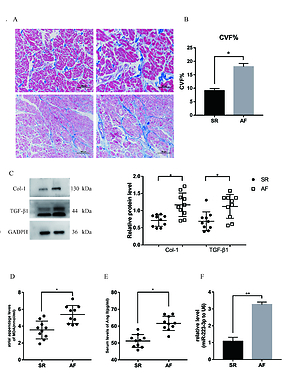Current issue
Archive
Manuscripts accepted
About the Journal
Editorial office
Editorial board
Section Editors
Abstracting and indexing
Subscription
Contact
Ethical standards and procedures
Most read articles
Instructions for authors
Article Processing Charge (APC)
Regulations of paying article processing charge (APC)
CARDIOLOGY / EXPERIMENTAL RESEARCH
MicroRNA-223-3p attenuates the angiotensin II-dependent ROS effect on cell viability by targeting NLRP3 in H9c2 cells
1
Department of Cardiology, the First Affiliated Hospital of Guangxi Medical University, Guangxi Cardiovascular Institute, Nanning, Guangxi, China
Submission date: 2019-12-18
Final revision date: 2020-02-16
Acceptance date: 2020-03-04
Online publication date: 2021-03-28
Corresponding author
Guoqiang Zhong
Department of Cardiology, the First Affiliated Hospital of Guangxi Medical University, Guangxi Cardiovascular Institute
Department of Cardiology, the First Affiliated Hospital of Guangxi Medical University, Guangxi Cardiovascular Institute
KEYWORDS
TOPICS
ABSTRACT
Introduction:
Recently, enhanced activation of NLRP3 has been reported to be involved in atrial fibrillation (AF). This study aimed to detect the correlation between oxidative stress and NLRP3 and explore the role of miR-223-3p in the reactive oxygen species (ROS) injury induced by Ang II.
Material and methods:
Serum Ang II levels were examined using an ELISA kit. Fibrosis levels of right atrial appendages were determined by Masson’s staining. H9c2 cells transfected with miR-223-3p mimics were treated with Ang II with or without MCC950 (a potent selective NLRP3 inhibitor). Cell viability was detected by CCK-8 assay. Protein abundance was detected by Western blot. The malondialdehyde assay and DCFH-DA were used to measure oxidative stress. RT-qPCR was used to assay the expression of miR-223-3p and NLRP3.
Results:
In total, 43 patients enrolled in this study, including 20 patients with persistent (chronic) AF (cAF). Compared with the sinus rhythm (SR) group, we found enhanced activation of the NLRP3 inflammasome which was positively correlated with oxidative stress and serum Ang II level in cAF patients. Ang II induced ROS generation and inhibited H9c2 cell viability. In addition, overexpression of miR-223-3p functioned as MCC950 which inhibited expression of the NLRP3 inflammasome and partly attenuated the effects of ROS induced by Ang II on H9c2 cell viability. Lastly, we used luciferase assay to confirm NLRP3 as a direct target gene of miR-223-3p.
Conclusions:
miR-223-3p has protective effects on oxidative stress induced by Ang II in AF by targeting NLRP3 and could provide a new potential intervention target for treatment of AF.
Recently, enhanced activation of NLRP3 has been reported to be involved in atrial fibrillation (AF). This study aimed to detect the correlation between oxidative stress and NLRP3 and explore the role of miR-223-3p in the reactive oxygen species (ROS) injury induced by Ang II.
Material and methods:
Serum Ang II levels were examined using an ELISA kit. Fibrosis levels of right atrial appendages were determined by Masson’s staining. H9c2 cells transfected with miR-223-3p mimics were treated with Ang II with or without MCC950 (a potent selective NLRP3 inhibitor). Cell viability was detected by CCK-8 assay. Protein abundance was detected by Western blot. The malondialdehyde assay and DCFH-DA were used to measure oxidative stress. RT-qPCR was used to assay the expression of miR-223-3p and NLRP3.
Results:
In total, 43 patients enrolled in this study, including 20 patients with persistent (chronic) AF (cAF). Compared with the sinus rhythm (SR) group, we found enhanced activation of the NLRP3 inflammasome which was positively correlated with oxidative stress and serum Ang II level in cAF patients. Ang II induced ROS generation and inhibited H9c2 cell viability. In addition, overexpression of miR-223-3p functioned as MCC950 which inhibited expression of the NLRP3 inflammasome and partly attenuated the effects of ROS induced by Ang II on H9c2 cell viability. Lastly, we used luciferase assay to confirm NLRP3 as a direct target gene of miR-223-3p.
Conclusions:
miR-223-3p has protective effects on oxidative stress induced by Ang II in AF by targeting NLRP3 and could provide a new potential intervention target for treatment of AF.
Share
RELATED ARTICLE
We process personal data collected when visiting the website. The function of obtaining information about users and their behavior is carried out by voluntarily entered information in forms and saving cookies in end devices. Data, including cookies, are used to provide services, improve the user experience and to analyze the traffic in accordance with the Privacy policy. Data are also collected and processed by Google Analytics tool (more).
You can change cookies settings in your browser. Restricted use of cookies in the browser configuration may affect some functionalities of the website.
You can change cookies settings in your browser. Restricted use of cookies in the browser configuration may affect some functionalities of the website.



